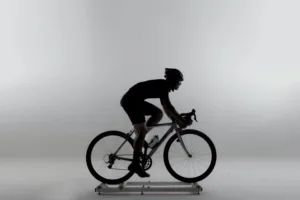Five tips to prepare for cycling in the dark are key to ensuring your safety and comfort on the bike this fall. As the days grow shorter and darkness descends earlier, cyclists should adapt their routines to safely navigate the roads during the autumn and early winter seasons. Cycling in low light conditions poses unique challenges, obvious but important among them are safety and visibility. Today we’ll discuss five tips to help improve your safety and confidence during the autumn months:

1. Illuminate Yourself
Pretty obvious, right? Investing in high-quality lights for your bike should be priority 1. Ensure that both the front and rear lights are in good working order (and ensure you have front and rear lights!) Consider using additional lights on your helmet or clothing. Many vendors are selling LED’s that affix to the wheels of your cycle as well, with increasing options for personalization. Opt for lights with multiple settings, including a steady beam and a flashing mode, to make yourself more noticeable to drivers. Front lights with at least 200 lumens are recommended for optimal visibility. Regularly check and replace the batteries to avoid unexpected failures during your rides. Many modern bike lights rely on charging, so ensure you have charging gear in your home or office and don’t get caught in a tricky situation.

2. Wear Reflective Gear
Dressing for visibility is just as crucial as equipping your bike with lights. Invest in reflective clothing, accessories, or gear that enhances your visibility to motorists. Reflective vests, ankle bands, and tape can significantly increase your profile in the dark. For the colder months there are a ton of options for jackets that are both warm and also enable high visibility. Choose clothing with reflective elements strategically placed on moving body parts, such as wrists and ankles, to create a dynamic signal that attracts attention. Enhancing your visibility from various angles will reduce the risk of collisions with vehicles.

3. Choose Well-Lit Routes
This may not always be an option, but selecting well-lit routes can make a substantial difference in your safety. Stick to well-maintained roads with streetlights whenever possible. Avoid shortcuts through poorly lit areas or secluded paths, as they increase the likelihood of encountering unseen obstacles and present higher risks of accidents. Familiarize yourself with the well-lit bike paths and roads in your area, and plan your routes accordingly. If you have limited options for well-lit routes, then point 1 becomes even more important.

4. Be Mindful of Weather Conditions
Autumn and winter often bring challenging weather conditions, including rain, snow, and fog. Before embarking on your ride, check the weather forecast and be prepared for adverse conditions. Ensure your bike is equipped with proper tires for slippery surfaces, and wear weather-appropriate clothing to stay warm and dry. Reduced visibility due to weather conditions can amplify the risks associated with cycling in the dark, so exercise extra caution and adjust your speed accordingly. Within the category of weather conditions, also be mindful of the temperature. Although this won’t have an impact on visibility, weather is often changeable in autumn and being under or over dressed can lead to discomfort.

5. Know Your Limits
Recognizing your personal comfort levels with cycling in the dark is crucial. If you feel uneasy or unsafe riding during low light conditions, it’s okay to opt for indoor alternatives (of which there are MANY options which we’ll discuss in more depth). Consider using stationary bikes, indoor cycling classes, or cycling simulators to maintain your fitness without exposing yourself to potential dangers on the road. Your safety should always be the top priority, and choosing indoor cycling during darker months is a responsible decision for those who may not feel confident navigating the roads in reduced visibility.
Conclusion
Autumn and winter cycling require heightened awareness and strategic precautions to ensure your safety and comfort. These five tips to prepare for cycling in the dark should you help you prepare. By prioritizing visibility, selecting well-lit routes, monitoring weather conditions, and knowing your personal limits, you can continue enjoying the benefits of cycling while minimizing the associated risks during darker seasons. Whether you choose to embrace the darkness with enhanced safety measures or opt for indoor alternatives, choosing the approach most comfortable for you is key to an enjoyable experience.


